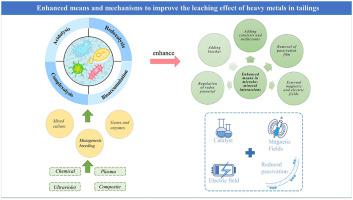当前位置:
X-MOL 学术
›
J. Environ. Manag.
›
论文详情
Our official English website, www.x-mol.net, welcomes your
feedback! (Note: you will need to create a separate account there.)
Bioleaching of heavy metals from metal tailings utilizing bacteria and fungi: Mechanisms, strengthen measures, and development prospect
Journal of Environmental Management ( IF 8.0 ) Pub Date : 2023-07-05 , DOI: 10.1016/j.jenvman.2023.118511 Yingbo Dong 1 , Jinyu Zan 2 , Hai Lin 2
Journal of Environmental Management ( IF 8.0 ) Pub Date : 2023-07-05 , DOI: 10.1016/j.jenvman.2023.118511 Yingbo Dong 1 , Jinyu Zan 2 , Hai Lin 2
Affiliation

|
Recovering key metals from secondary sources is an indispensable strategy for preventing metal shortages and reducing the risk of toxic releases into the environment. Metal mineral resources continue to be depleted and the global supply chain will face metal scarcity. The use of microorganisms for metal transformation plays an important role in the bioremediation of secondary resources. It shows great potential for development due to its compatibility with the environment and possible cost effectiveness. The results of the study show that the influence of bioleaching processes and effects are mainly analyzed from microorganisms, mineral properties and leaching environmental conditions. In this review article, we elucidate light on the role and mechanisms of fungi and bacteria involved in extracting different metals from tailings, including acidolysis, complexolysis, redoxolysis, and bioaccumulation. Key process parameters that affect the efficiency based bioleaching are discussed, providing referenceable pathways to improve leaching efficiency. The investigation concludes that exploitation of the functional genetic role of microorganisms and their optimal growth conditions can achieve efficient leaching of metals. It was found that the improvement of microbial performance was achieved at the level of mutagenesis breeding, mixed culture microorganisms, and genetics. Moreover, control of leaching system parameters and removal of passivation films can be achieved by adding biochar and surfactants in the leaching system as an effective means to improve tailings leaching. Knowledge about cells with minerals and their detailed interactions at the molecular level is still relatively scarce and the field could be deepened and this area needs to be further explored in the future. The challenges and the key issues associated with the bioleaching technology development are elaborated as a green and effective bioremediation strategy for the environment and prospects for imminent are also highlighted.
中文翻译:

利用细菌和真菌生物浸出金属尾矿重金属:机理、强化措施及发展前景
从二次来源中回收关键金属是防止金属短缺和降低有毒物质释放到环境中的风险不可或缺的策略。金属矿产资源持续枯竭,全球供应链将面临金属稀缺。利用微生物进行金属转化在二次资源的生物修复中发挥着重要作用。由于其与环境的兼容性和可能的成本效益,它显示出巨大的发展潜力。研究结果表明,生物浸出过程和效果的影响主要从微生物、矿物性质和浸出环境条件等方面进行分析。在这篇综述文章中,我们阐明了真菌和细菌在从尾矿中提取不同金属的过程中的作用和机制,包括酸解、络合分解、氧化还原和生物富集。讨论了影响生物浸出效率的关键工艺参数,为提高浸出效率提供了可参考的途径。研究结论是,利用微生物的功能遗传作用及其最佳生长条件可以实现金属的有效浸出。研究发现,微生物性能的改善是在诱变育种、混培养微生物和遗传学水平上实现的。此外,通过在浸出系统中添加生物炭和表面活性剂可以实现浸出系统参数的控制和钝化膜的去除,是改善尾矿浸出的有效手段。关于细胞与矿物质及其在分子水平上的详细相互作用的知识仍然相对匮乏,该领域可以深化,并且需要在未来进一步探索。 阐述了与生物浸出技术发展相关的挑战和关键问题,作为一种绿色有效的环境生物修复策略,并强调了迫在眉睫的前景。
更新日期:2023-07-05
中文翻译:

利用细菌和真菌生物浸出金属尾矿重金属:机理、强化措施及发展前景
从二次来源中回收关键金属是防止金属短缺和降低有毒物质释放到环境中的风险不可或缺的策略。金属矿产资源持续枯竭,全球供应链将面临金属稀缺。利用微生物进行金属转化在二次资源的生物修复中发挥着重要作用。由于其与环境的兼容性和可能的成本效益,它显示出巨大的发展潜力。研究结果表明,生物浸出过程和效果的影响主要从微生物、矿物性质和浸出环境条件等方面进行分析。在这篇综述文章中,我们阐明了真菌和细菌在从尾矿中提取不同金属的过程中的作用和机制,包括酸解、络合分解、氧化还原和生物富集。讨论了影响生物浸出效率的关键工艺参数,为提高浸出效率提供了可参考的途径。研究结论是,利用微生物的功能遗传作用及其最佳生长条件可以实现金属的有效浸出。研究发现,微生物性能的改善是在诱变育种、混培养微生物和遗传学水平上实现的。此外,通过在浸出系统中添加生物炭和表面活性剂可以实现浸出系统参数的控制和钝化膜的去除,是改善尾矿浸出的有效手段。关于细胞与矿物质及其在分子水平上的详细相互作用的知识仍然相对匮乏,该领域可以深化,并且需要在未来进一步探索。 阐述了与生物浸出技术发展相关的挑战和关键问题,作为一种绿色有效的环境生物修复策略,并强调了迫在眉睫的前景。













































 京公网安备 11010802027423号
京公网安备 11010802027423号